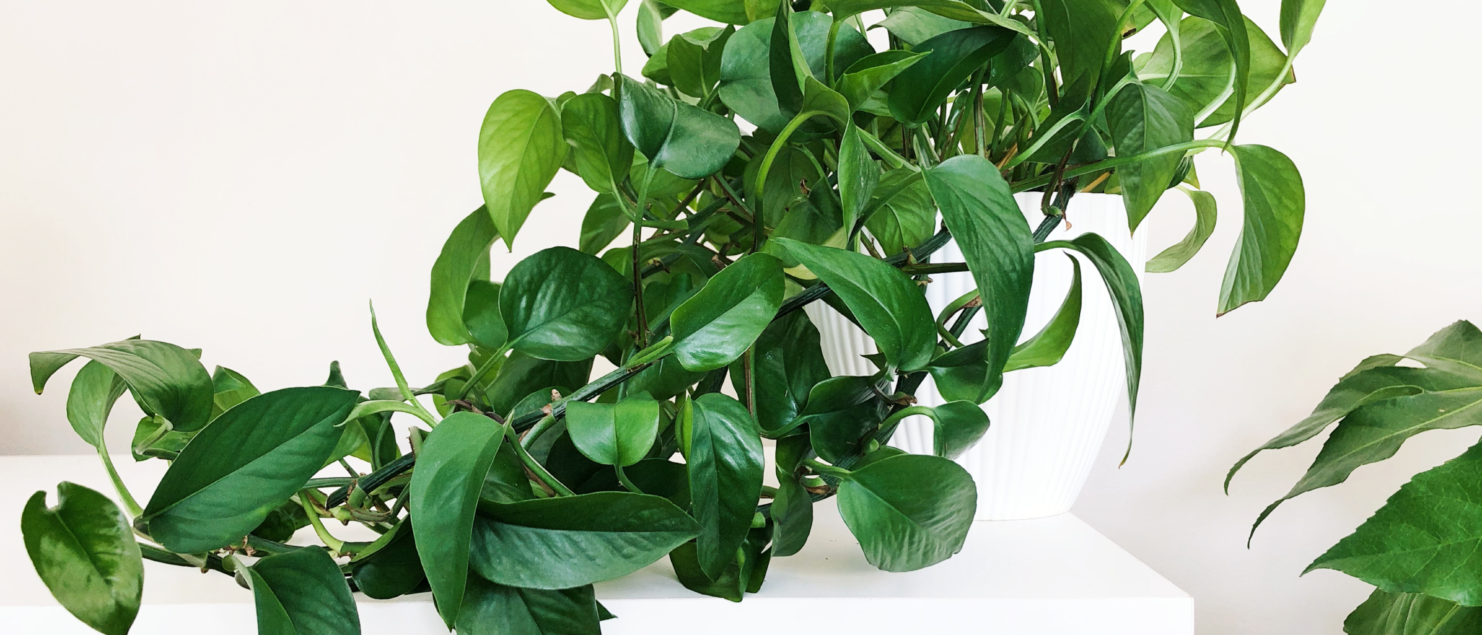How To Care For A Pothos
When it comes to a beginner houseplant – look no further than the Epipremnum Aureum Aka Pothos. These leafy vining houseplants are always listed as one of the top plants for anyone…and I mean anyone.
This houseplant is among the few that I tell new plant parents or even the ones who “can’t keep anything alive” to start out with. Not only is the Pothos plant not needy, it’s also not picky on location (for the most part).
Let’s get into why you need a Pothos plant in your home and how easy it really is to care for these plants.
Behaviors & Characteristics
Growing Patterns
Most of the time indoors you’ll see a Pothos trailing all over the home. But in the wild you can catch the Pothos climbing up tree trunks or fences.
This plant is very versatile when it comes to growing in the home. If given a moss pole or something natural to attach its aerial roots on, it will be super happy to climb. In most cases Pothos develop larger leaves and even fenestrations on a more mature plant.
Pothos are also happy to trail as well. Pop that Pothos in a hanging planter or on a shelf and watch it as it takes over, creating a curtain of leafy goodness. Pothos won’t normally grow the larger leaves when trailing, but the smaller leaves are just as pretty.

Whether you opt into a trailing or a climbing Pothos, these plants can get big and are fairly fast growers. They can reach several feet in no time. Make sure you have adequate room for it to grow in your home.
Varieties/Types
The Pothos plant comes in many shapes and colors. Some of the most popular varieties is the Jade, Marble Queen, and the Snow Queen. The Jade Pothos has rich glossy emerald foliage, where the Marble Queen and the Snow Queen have more marbling and variegation.
One of the more unique Pothos varieties is the Pearl and Jade, which have bold cream/white markings throughout a bright green leaf.

Pothos Care
Watering
When it comes to Pothos plant care, the best things about watering your Pothos is it will basically let you know it needs it. The leaves will start to look dull, wrinkly, and limp. Give your Pothos a good drink when this happens, and it will perk back up in a few hours.
Water your Pothos with room temperature water until water starts to drain through the drainage holes.
To avoid having your Pothos beg you for water, check on it once a week with a moisture meter or the finger test. If the soil feels dry or the pot is light, then its time to water. I tend to check on mine every Sunday and water when they need it.
Generally, Pothos need water every 7-12 days in the spring and summer months. Watering will also depend on its location. If your Pothos is in a drafty area or a sunny window it may dry out a bit faster. In the fall and winter, you’ll find you plant not needing as much water.
Fertilizing
A balanced fertilizer like a 20-20-20 or a 10-10-10 is recommended for Pothos. In the spring and summer make sure you’re fertilizing your Pothos every 3-4 weeks and slowing down in the fall and winter.
Lighting
Pothos are known for being a plant that you can put just about anywhere. They do well in medium light with no direct sun rays. Direct sun can cause burning and or bleaching on the foliage. Pothos can survive in a lower light setting, but don’t expect it to thrive.

Varieties that have more variegation need the brighter light to maintain their marbling. If any plant with variegation isn’t in a brighter location, it can start to revert to a non-variegated version. Most varieties of variegation on Pothos are stable, so if you’re starting to lose the marbling, move it to a brighter spot.
Temperature & Humidity
Don’t let the temperature around your Pothos drop below 50 degrees for a long period of time. Pothos are native to more tropical climates, but normal room temperature is completely fine. They thrive in temps from 70-90 degrees.
These tropical vines love a home between 50-70%. If you live in a drier climate, consider getting a small humidifier to keep near your Pothos.
Soil
Plant your Pothos in a rich soil that is fast draining. Normal houseplant potting soil with a bit of added perlite will be the perfect mix for your plant.
Propagation
If your Pothos becomes unruly or you want to add another Pothos baby into your collection, then you’re in luck because propagating a Pothos is the easiest!

Take a cutting 2 inches below the node and place it in your desired propagation media.
Here’s a complete guide on how to propagate plants: Click here.
Common Problems
Letting your Pothos dry out for a long period of time or not fertilizing will cause leaves to yellow. Other foliage issues this plant can face is fungal leaf spot disease. Both leaf issues can be resolved with pruning off affected leaves.
Pests love a Pothos. Many pests like spider mites, mealy bugs, thrips – basically any common houseplant pest can infest a Pothos. Making sure you keep the leaves wiped off and checking for pest periodically (especially in the growing season) will help you avoid a bigger issue down the road.
If you find pests on your Pothos plant: Click here.
The Goodest Boy Of The Houseplants
Its loyal. It’s forgiving. It’s cute.

Pothos is and will forever be on any “easy to care for” plant list – and for good reason. I like to call the Pothos the ‘set it and forget it plant’. Which is why I always recommend this plant to all plant parents alike.


